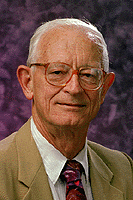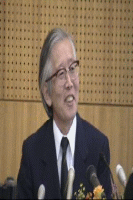|
Americans Alan Heeger and Alan MacDiarmid and Japan's Hideki Shirakawa won the 2000 Nobel Prize in Chemistry for discovering that plastic can be made to conduct electricity.
Plastics, generally thought to be incapable of conducting electricity, are polymers, molecules whose structure is repeated in long chains. Heeger, MacDiarmid and Shirakawa showed that polymers can conduct electricity if they are "doped" by removing or introducing electrons and if they consist alternately of single and double bonds between carbon atoms.
Conductive plastics are useful for photographic film, computer screens and mobile phone displays. The three researchers' work has also led to the development of light-emitting diodes and molecular electronics. Research in these areas could lead to luminous surfaces that do not need bulbs and the reduction of transistors and electrical components to a molecular scale.
Heeger, MacDiarmid and Shirakawa made their key findings in the late 1970s. MacDiarmid had invited Shirakawa to the University of Pennsylvania to study polymers after they met during a coffee break at a conference in Japan.

Alan Heeger
Professor and his colleagues at the University of California, Santa Barbara have done pioneering research in the area of semiconducting and metallic polymers. This class of novel materials has the electrical and optical properties of semiconductors and metals in combination with the processing advantages and mechanical properties of polymers. His current research interests lie in the area of transport in semiconducting polymers and light emission from semiconducting polymers (both photoluminescence and electroluminescence). His research group focuses on issues related to the fundamental electronic structure of this novel class of materials and carries out studies of light emitting diodes (LEDs), light-emitting electrochemical cells (LECs), and lasers, all fabricated from semiconducting (conjugated) polymers. Experimental facilities provide the capability for a broad range of spectroscopic studies (including ultrafast, fs, time resolved spectroscopy), quantitative measurement of photoluminescence and electroluminescence quantum efficiencies, optical gain/loss of conjugated polymer/oligomer laser materials, and photoconductivity (steady state and time resolved with sub-ns time resolution).

Alan MacDiarmid
Alan G. MacDiarmid (born April 14, 1927; mother, Ruby and father, Archibald MacDiarmid ) grew up in New Zealand, and received his Ph.D. at University of Wisconsin 1953 and at University of Cambridge, UK, 1955. He was associate professor at University of Pennsylvania 1956 and received a professorship there 1964. Since 1988 he is Blanchard Professor of Chemistry.
In 1973, he began research on (SN)x, an unusual polymeric material with metallic conductivity. His interest in organic conducting polymers began in 1975 when he was introduced to a new form of polyacetylene by Dr. Hideki Shirakawa at the Tokyo Institute of Technology. The ensuing collaboration between MacDiarmid, Shirakawa and Alan Heeger (then at the Department of Physics at the University of Pennsylvania) led to the historic discovery of metallic conductivity in an organic polymer.
MacDiarmid recalled that he invited Shirakawa to Penn to study polymers after they met over a cup of green tea at a conference at the Tokyo Institute of Technology, where MacDiarmid was giving a lecture. When MacDiarmid—who noted that he likes “pretty things”—showed Shirakawa a “golden-colored” polymer made of silver nitride, Shirakawa showed him a “beautiful silvery polymer” made of polyacetylene. “I said, ‘If I can get some money, could you come and join me for a year at Penn?’” MacDiarmid said. “And he said ‘Yes.’” While at Penn, they soon found that Shirakawa’s silvery polymer “showed some conductivity, not very high, but this elemental analysis also showed that there was impurity in it. So we said, ‘Well, obviously, you make it more pure, you get a higher conductivity.’” But, MacDiarmid noted, Shirakawa found that “the purer he got it, the more the conductivity decreased instead of increasing.” They then added iodine, which removed some of the tightly packed electrons, “and suddenly the conductivity increased within a few seconds to millions and billions of times higher than what it was before.”
MacDiarmid and Heeger enjoyed a “very, very crucial and successful collaboration for about 10 years,” MacDiarmid recalled. “We would arrange to get together every Saturday morning—we strictly said not to discuss anything specific; purely to sit down and let our minds wander and consider crazy things, which we did.” From his point of view, MacDiarmid said, the “whole climate of Penn is really just great” for research, and its interdisciplinary strengths are complemented by the quality of its students. “We all know that the research done in a given research group cannot be better than the students—undergraduate, graduate or post-doctoral,” he said. “If you have very good people working—not for you but with you, then the chances of finding very important, critical, unexpected things are pretty high.”
This initial discovery and ensuing studies, in collaboration with Shirakawa, resulted in the first chemical doping of (CH)x and detailed physics studies with Heeger. That an organic polymer could be readily doped to the metallic regime introduced a phenomenon, completely new and unexpected to both the chemistry and physics communities. This unleashed a flood-gate of research world-wide in chemistry and physics concerning interrelationships between the chemistry, structure and electronic properties of semiconducting and metallic organic polymers which has continued to expand unabatedly to this day.

Hideki Shirakawa
Professor Shirakawa has been a faculty member of Institute of Materials Science, University of Tsukuba for more than 20 years and has dedicated his life to both his research and education.
He explored a unprecedented new area of polymer science by leading insulating polyacetylene to electrically conducting one. This achievement was often said to be triggered by an accidental mistake --a thousand fold too much catalyst was added during synthesis of polymer-- resulting in a beautiful silvery film which possess many superior properties to metals when he was a research associate of Chemical Resources Laboratory at Tokyo Institute of Technology.
When Professor Alan MacDiarmid heard about the film synthesized by Dr. Shirakawa, he invited him to the University of Pennsylvania in Philadelphia as a post-doctral fellow. They worked together with Dr. Alan Heeger in order to understand the mechanisms of the appearance of conductivity in insulating polymers and finally came to a conclusion that it is possible to introduce carriers in polymers by doping: modifying polyacetylene by oxidation with halogen vapor.
In 1977, Shirakawa, Heeger, MacDiarmid, and others published their discoveries in "Synthesis of electrically conducting organic polymers: Halogen derivatives of polyacetilene (CH)n" in The Journal of Chemical Society, Chemical Communications.
The discovery was considered a major breakthrough in the field of polymer science.
Since then, the field has grown greatly and has also led to immerse new applications in the present days.
For example, LEDs (light emitting diode), new color screens, batteries, and etc.
We think that in the 21st century this development will proceed further from polymer based electronics
to real molecular based nano-scale integrated circuits instead of presently used silicon based electronics.
We also believe and hope that this kind of nano-scale materials science will bring us further property
in our human society. | | | |


